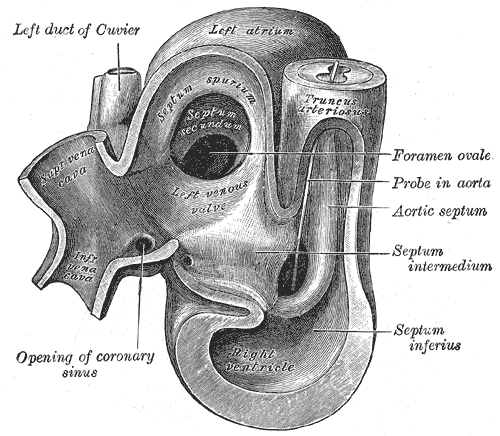Atrial septal defect anatomy
|
Atrial Septal Defect Microchapters | |
|
Treatment | |
|---|---|
|
Surgery | |
|
| |
|
Special Scenarios | |
|
Case Studies | |
|
Atrial septal defect anatomy On the Web | |
|
American Roentgen Ray Society Images of Atrial septal defect anatomy | |
|
Risk calculators and risk factors for Atrial septal defect anatomy | |
Editor-In-Chief: C. Michael Gibson, M.S., M.D. [1]; Associate Editor(s)-In-Chief: Priyamvada Singh, M.B.B.S. [2]; Assistant Editor(s)-In-Chief: Kristin Feeney, B.S. [3]
Overview
The embryological development of human fetal heart takes place as early as 4th week of intrauterine life. The normal septal development requires a proper alignment and fusion of the two interatrial septums i.e. septum primum and septum secundum. Failure to do so may lead to the development of atrial septal defects.
Anatomy
The development of the fetal heart takes place as early as the 4th week of gestation. An abnormal septal development at this stage may lead to atrial septal defect.
Embryogenesis
Normal septal embryogenesis occurs as follows:
- The developing heart has an orifice called ostium primum or primary interatrial foramen between the atrium that serves as an opening between the free edge of the septum primum and the AV cushions.
- A septum primum arises from the superior portion of the common atrium of the developing heart. It serves to subdivide the cavity of the primitive atrium into right and left chambers.
- An endocardial cushion is located between the atria and ventricles, serving to create the infrastructure to the basis of the four-chambered heart formation.
- Septum primum grows downward to the endocardial cushions. This leads to the closing of the orifice (ostium primum) between the atria.
- A second entity, the septum secundum, develops to the right of the septum primum and the opening between the upper and lower limbs of the septum secundum is known as the foramen ovale of the heart and persists until birth. These two septae fuse later in life to complete the formation of the atrial septum.
- In the fetus this orifice allows shunting of blood from right to left side of the heart. This is so because during the fetal life right side heart pressures are more than the systemic pressure. However, there is a reversal of pressure gradient after birth (systemic pressures becomes more than right sided pressure) and this change of pressure causes the septum primum to be held against the septum secundum and closing the interatrial shunt.
- In approximately 30% of population the septum primum and secundum fails to fuse leading to patent foramen ovale (PFO) in the newborn. In this case, elevation of pressure in the pulmonary circulatory system (ie: pulmonary hypertension due to various causes, or transiently during a cough) can cause the foramen ovale to remain open. The patent foramen ovale can be of two types:
- Completely covered but not completely sealed so that the foramen can be opened with reversal of shunt. This is also sometimes called as a probe patent or patent foramen ovale (PFO)
- An open communication exists between right and left atrium persists is the true definition of what is known as an atrial septal defect (ASD).
